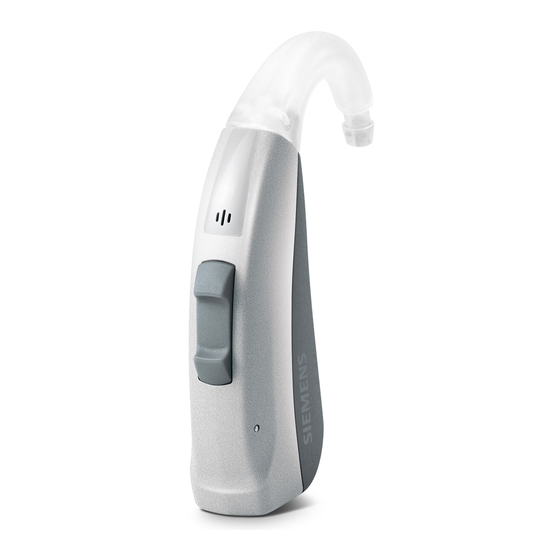
Summarization of Contents
Your Hearing Instruments
Getting to Know Your Instruments
Familiarize yourself with your new hearing instruments by using the controls and noting their locations.
Components and Names
Identify the type of hearing instrument and its parts using diagrams for Orion/Sirion S, M, and P.
Controls
Push Button Operation
Details the functions of the push button for program change, volume, and standby/turn on.
Rocker Switch Operation
Details the functions of the rocker switch for program, volume, tinnitus noiser, sound balance, and standby/turn on.
Settings
Hearing Programs and Features
Information on hearing programs, power-on delay, e2e wireless, telecoil, and accessories like remote control.
Battery Size and Ear Pieces
Battery Options
Details on available non-rechargeable battery sizes, specifically size 13 and 312.
Exchangeable Ear Pieces
Information on different types of exchangeable ear pieces (LifeTips) for hearing instruments with LifeTubes.
Service Information
Serial Numbers and Service Dates
Fields to record serial numbers, service dates, and date of purchase for the hearing instruments.
Batteries
Replacing Non-Rechargeable Batteries
Instructions on how to remove and replace non-rechargeable batteries in the hearing instruments.
Daily Use
Turning On and Off
Methods for turning hearing instruments on and off via battery compartment, controls, or remote.
Inserting and Removing Instruments
Step-by-step guide for inserting and removing hearing instruments, including safety precautions.
Adjusting Volume and Programs
How to adjust volume automatically or manually, and change hearing programs for different situations.
Locking Controls and Using Two Instruments
Optional control locking and guidance for using two instruments simultaneously or separately.
On the Phone
Telephone Program Usage
Advice on aligning the telephone receiver with the ear and using a dedicated telephone program.
Audio Induction Loops
Telecoil Program and Remote Control
How to use the telecoil program in places with induction loops and considerations for remote control usage.
Audio Input
Attaching and Removing the Audio Shoe
Instructions on how to attach or remove the audio shoe, noting it requires battery compartment exchange.
Maintenance and Care
Cleaning Procedures
Daily cleaning of instruments and LifeTubes, avoiding water and using appropriate tools.
Drying, Storage, and Part Exchange
Guidance on drying instruments, proper storage, and recommended exchange of ear pieces and tubes.
Troubleshooting
Common Problems and Solutions
Lists common issues like weak sound, whistling, distorted sound, signal tones, and non-working instruments with their solutions.
Important Information
Intended Use and Symbols
Defines the intended use of hearing instruments and explains important warning and information symbols.
Transport and Storage Conditions
Specifies environmental conditions (temperature, humidity, air pressure) for transport and storage.
Disposal and Technical Information
Disposal Information
Guidelines for recycling hearing instruments, accessories, and batteries according to national regulations.
Technical Information
Provides technical specifications like FCC ID, IC, operating frequencies, and compliance labels.
FCC and IC Compliance
FCC Compliance Details
Information on FCC and IC compliance, including operating conditions and limits for Class B digital devices.
Conformance Information
CE Marking and Directives
Confirms compliance with European directives (93/42/EEC, 99/5/EC) for medical devices and radio equipment.
Important Safety Information
Personal Safety and Hazards
Covers risks like injury, electronic interference, hearing impairment, explosion, and choking.
Product Safety and Tinnitus Noiser
Guidelines for protecting instruments from environmental factors and safe use of the tinnitus noiser.














Need help?
Do you have a question about the Sirion S and is the answer not in the manual?
Questions and answers